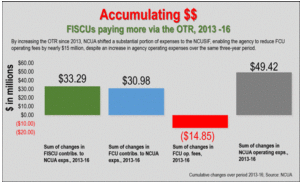Overhead Transfer Rate Resources
Overhead Transfer Rate (OTR) Resources
The “overhead transfer rate” is the percentage of annual expenses that the NCUA Board uses to determine the amount it will take from the National Credit Union Share Insurance Fund (NCUSIF) to cover the NCUA’s annual “insurance-related” expenses. The following resources from NASCUS illustrate our continuing efforts on the issue.
Dec. 9, 2021 – President and CEO Lucy Ito Testifies on OTR During the 2022 NCUA Budget Briefing
OTR history, 1986 – Present
JUNE 2017 NCUA PROPOSED RULE/METHODOLOGY
- NCUA proposal (from Federal Register, June 30)
- NCUA request for comment regarding revised overhead transfer rate methodology
- NCUA staff presentation on the proposed changes to the overhead transfer rate methodology
- NASCUS President and CEO Lucy Ito statement on OTR proposal
2016 COMMENT LETTERS
The following are among those that have been submitted in response to NCUA’s January, 2016 request for comments on the OTR methodology; comments were due April 26:
- April 27: CU Answers
- April 26: Atchison Village Credit Union
- April 26: California and Nevada Credit Union Leagues
- April 26: Cooperative Credit Union Association
- April 26: Credit Union, Inc.
- April 26: CU Association of the Dakotas (CUAD)
- April 26: CU Counsel, Pllc
- April 26: Dow Chemical Employees’ Credit Union
- April 26: Georgia Credit Union Affiliates
- April 26: Heartland Credit Union Association
- April 26: Hometown Credit Union
- April 26: Illinois Credit Union League
- April 26: Indiana Credit Union League
- April 26: Michigan Credit Union League & Affiliates
- April 26: Mutual Security Credit Union
- April 26: NASCUS
- April 26: Ohio Credit Union League
- April 26: WI Department of Financial Institutions
- April 26: ID Department of Finance
- April 26: GA Department of Banking and Finance
- April 26: IL Department of Financial and Professional Regulation
- April 26: BECU
- April 26: Technology Credit Union (TechCU)
- April 26: Credit Union Natl. Assn.
- April 25: Capital Credit Union
- April 25: Connex Credit Union
- April 25: Town & Country Credit Union
- April 25: Wisconsin Credit Union League (WCUL)
- April 25: Connecticut Dept. of Banking
- April 25: Pennsylvania Credit Union Association (PCUA)
- April 22: Elm River Credit Union
- April 22: Natl. Assn. of Federal Credit Unions
- April 22: MECU
- April 18, Railway Credit Union
- April 15: League of Southeastern Credit Unions (LSCU)
- April 15: Washington Division of Credit Unions
- April 13: Texas CU Department
- April 1: North Dakota Department of Financial Institutions
- March 31: Safe1 Credit Union
- Jan. 15: Pantea Consulting
NCUA page showing OTR letters posted, to date
RESOURCES
COMMENT ON OTR METHODOLOGY
NASCUS President and CEO Lucy Ito urges the state credit union system to weigh in on the OTR methodology by April 26.
The ‘overhead transfer rate’ (OTR) in brief from nascus on Vimeo.
Updated for 2016, the “overhead transfer rate” (OTR) by NCUA is explained in this very brief video in simple terms. The video details the mechanics of the OTR, and its impact on state-chartered credit unions

NASCUS graphic: The accumulating cost of a rising OTR (hi-res image)
Price Waterhouse Coopers OTR review (unredacted), January, 2011
Comments by NCUA Board Chairman Debbie Matz, Nov. 19, 2015, re: Overhead Transfer Rate (OTR)
Comments by NCUA Board Member J. Mark McWatters, Nov. 19, 2015, re: Overhead Transfer Rate (OTR)
2015 NCUA Aug. 18 legal opinion on APA applicability to OTR
2015 NASCUS response to NCUA General Counsel Mike McKenna
2015 NCUA General Counsel Mike McKenna letter to NASCUS
2015 Legal analysis: Comprehensive legal study of the OTR; subject to notice and comment requirements
2015 Letter to Capitol Hill: Support for NCUA budget transparency measure
2003 Whitepaper: Restructuring NCUA
2001 Legal study: Authority of NCUA to Allocate Costs to The NCUSIF